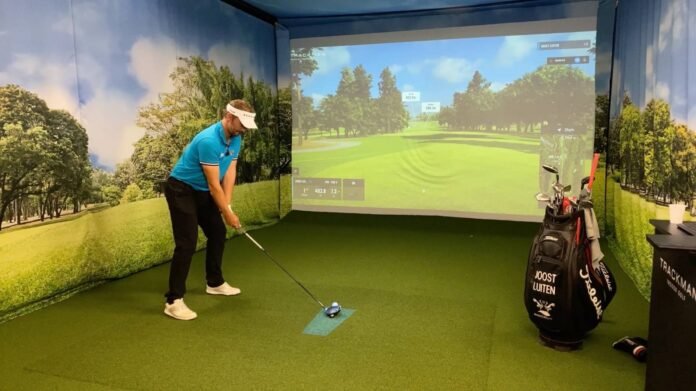Introduction
Imagine being able to practice your golf swing, improve your game, and enjoy a round of golf without leaving the comfort of your home. Golf simulators are no longer a luxury reserved for professional golfers or high-end golf clubs—they’ve become increasingly popular for home use, offering an immersive, realistic experience that can help you take your game to the next level. In this article, we’ll dive into everything you need to know about golf simulators for home use, from understanding how they work to choosing the best one for your needs.
Understanding Golf Simulators
What is a Golf Simulator?
A golf simulator is a system that allows you to play and practice golf in a virtual environment, replicating the experience of being on a real golf course. It uses a combination of sensors, cameras, and software to track your swing and ball flight, projecting the results onto a screen where you can see the trajectory of your shot and its outcome.
How Golf Simulators Work
Golf simulators work by tracking various data points, such as the speed, angle, and spin of your golf ball after you hit it. This data is then processed by the golf simulators for home software, which creates a visual representation of the shot on a virtual course. The accuracy of this representation depends on the quality of the simulator’s components, such as its sensors and software.
Key Components of a Golf Simulator
A typical golf simulator setup includes:
- Launch Monitor: Tracks the data of your shot.
- Projector and Screen: Displays the virtual golf course and shot.
- Computer/Software: Processes the data and runs the simulation.
- Hitting Mat and Net: Allows you to hit the ball safely indoors.
- Sensors or Cameras: Capture the details of your swing and ball flight.
Types of Golf Simulators
Infrared-Based Simulators
These simulators use infrared light to track the movement of your golf club and ball. They are often more affordable but might not be as accurate as other types.
Camera-Based Simulators
Camera-based systems use high-speed cameras to capture detailed information about your swing and ball flight. These are generally more accurate and provide a more realistic experience.
Radar-Based Simulators
Radar-based simulators, like those used by professional golfers, track the ball’s movement with radar technology. They offer the highest level of accuracy but tend to be more expensive.
Comparison of Different Types
Each type of golf simulator has its pros and cons. Infrared simulators are budget-friendly but less accurate, while camera-based simulators strike a good balance between price and precision. Radar-based systems are top-tier in accuracy but come with a higher price tag.
Key Features to Consider When Buying a Golf Simulator
Accuracy and Realism
Accuracy is paramount in a golf simulator. Look for models with high-quality sensors or cameras that can provide realistic ball flight data.
Space Requirements
Before purchasing, ensure you have enough space for the simulator. This includes not just floor space but also ceiling height, as some simulators require a high ceiling for a full swing.
Software Features and Game Options
Good software can significantly enhance your experience. Look for simulators that offer a variety of courses, training modules, and multiplayer options.
Connectivity and Compatibility
Ensure the simulator is compatible with your devices, such as PCs, tablets, or smartphones, and can connect easily to the internet for updates and online play.
Price and Budget Considerations
Golf simulators range in price from a few hundred dollars to tens of thousands. Determine your budget beforehand and look for a simulator that offers the best features within that range.
Top Golf Simulator Brands for Home Use
SkyTrak
SkyTrak is known for its affordability and high accuracy, making it a popular choice for home use.
TrackMan
TrackMan offers professional-level accuracy and is used by many PGA pros. It’s one of the more expensive options but worth it for serious golfers.
OptiShot
OptiShot is a budget-friendly option that provides a solid golf simulation experience without breaking the bank.
Foresight Sports
Foresight Sports offers high-end golf simulators for home with excellent accuracy and a wide range of features.
Mevo Plus
Mevo Plus is a portable and affordable option that still delivers impressive accuracy and features.
Setting Up a Golf Simulator at Home
Choosing the Right Space in Your Home
The first step in setting up your simulator is finding the right space. A basement, garage, or spare room can all be good options.
Space and Ceiling Height Requirements
Make sure the space is large enough to accommodate the simulator and that the ceiling is high enough for you to swing comfortably.
Necessary Equipment and Accessories
In addition to the simulator itself, you’ll need a hitting mat, a net, and possibly a projector. Some setups also include additional lighting or sound systems.
Tips for Optimizing the Setup
To get the best experience, ensure your hitting mat is level, your screen is positioned correctly, and there’s minimal ambient light affecting the projector.
Golf Simulator Software: An In-Depth Look
Types of Golf Simulation Software
There are various software options available, from basic programs that offer a few courses to advanced ones with dozens of options and customization features.
Features to Look for in Software
Look for software that offers realistic graphics, a variety of courses, training tools, and multiplayer modes.
Popular Software Options and Their Benefits
Some popular software options include E6 Connect, The Golf Club, and FSX 2020. Each has its strengths, such as course variety or detailed swing analysis.
Software Updates and Customer Support
Good software is regularly updated with new features and courses. Also, check if the company offers strong customer support in case you run into issues.
Enhancing Your Golf Simulator Experience
Upgrading Your Golf Simulator Over Time
As you get more into using your simulator, you may want to upgrade components, such as adding better sensors or a higher-quality projector.
Adding Extra Features Like Swing Analyzers
Swing analyzers can provide additional data to help you improve your game, making your simulator even more valuable.
How to Make the Experience More Immersive
Consider adding surround sound, realistic lighting, or even VR components to create a more immersive golf experience.
Maintenance and Care of Your Golf Simulator
Cleaning and Maintaining the Hardware
Regularly clean your hitting mat, sensors, and screen to keep everything in good working order.
Regular Software Updates
Keep your simulator software up to date to benefit from the latest features and improvements.
Troubleshooting Common Issues
If you encounter issues, such as lagging or inaccurate data, check the user manual or contact customer support for help.
Cost Considerations: Budgeting for a Home Golf Simulator
Breaking Down the Costs
Costs include the simulator itself, additional equipment like nets and mats, and the software. Installation can also add to the total expense.
Financing Options for More Expensive Setups
Some companies offer financing options, allowing you to pay for your simulator over time rather than upfront.
Ways to Save Money Without Compromising Quality
Consider buying a used simulator, opting for a more basic setup, or gradually upgrading your system over time.
Benefits of Using a Golf Simulator at Home
Improvement in Golf Skills
Regular practice on a simulator can lead to noticeable improvements in your golf game, particularly in areas like swing consistency and accuracy.
Convenience and Time-Saving Benefits
No need to drive to the golf course—you can practice whenever you have a few minutes to spare.
Entertainment Value for Family and Friends
A golf simulator isn’t just for serious practice; it can also be a fun way to entertain friends and family.
Year-Round Practice Regardless of Weather
Whether it’s raining, snowing, or just too hot, you can still practice your golf game in the comfort of your home.
Common Challenges and How to Overcome Them
Space Constraints
If space is an issue, consider a more compact simulator or a setup that can be easily stored when not in use.
Learning Curve for New Users
Golf simulators can be complex, but most come with user-friendly manuals and customer support to help you get started.
Dealing with Software Glitches
Software isn’t perfect, and glitches can happen. Keeping your system updated and contacting support when needed can help resolve these issues.
Balancing Realism with Budget
While it’s tempting to go for the most realistic simulator, remember to balance your desire for realism with your budget constraints.
Customer Reviews and Testimonials
Real-Life Experiences of Users
Many users find that having a golf simulator at home significantly improves their game and provides endless hours of entertainment.
Common Positive Feedback
Users often praise the convenience, accuracy, and variety of courses available with home golf simulators.
Potential Drawbacks Mentioned by Users
Some users note that the initial setup can be challenging and that software updates are sometimes necessary to fix bugs.
Future Trends in Home Golf Simulators
Innovations in Technology
As technology advances, golf simulators are becoming more accurate, affordable, and user-friendly.
The Rise of VR in Golf Simulators
Virtual reality is the next big thing, offering even more immersive and realistic golf experiences at home.
Predicting the Future of Home Golf Simulation
Expect to see continued growth in the market, with more options for every budget and skill level.
Conclusion
Investing in a home golf simulator can be a game-changer for avid golfers, offering a convenient way to practice, improve, and enjoy golf year-round. Whether you’re a seasoned pro or just starting, there’s a simulator out there that can fit your needs and budget. With the right setup, your home can become your personal golf sanctuary.
FAQs
What is the ideal space required for a home golf simulator?
The ideal space depends on the simulator, but typically, you need at least 10 feet of ceiling height, 10 feet of width, and 12 feet of depth.
Are golf simulators accurate?
Yes, many golf simulators are highly accurate, especially those with advanced sensors or cameras. The accuracy can be within a few yards of real-life shots.
Can I use my real golf clubs with a simulator?
Absolutely! Most simulators are designed for use with real golf clubs and balls.
How much does a decent home golf simulator cost?
A decent home golf simulator can range from $500 for basic models to over $20,000 for high-end systems.
Is it possible to install a golf simulator in an apartment?
Yes, as long as you have enough space and ceiling height. Compact models or portable simulators are ideal for smaller spaces like apartments.




